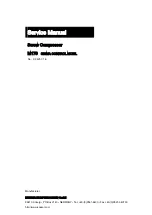
1. Layout (Fig. 1/2/3)
1. Intake air filter
2. Pressure vessel
3. Wheel
4. Drainage screw for condensation water
5. Supporting foot
6. Oil drain plug / sight-glass
7. Safety valve
8. Quick-lock coupling
9. Oil sealing plug (oil filler opening)
10.Transportation handle
11.ON/OFF switch
12.Pressure switch
13.Pressure gauge (for reading the tank pressure)
Important!
When using the equipment, a few safety precautions must
be observed to avoid injuries and damage. Please read the
complete operating manual with due care. Keep this manu-
al in a safe place, so that the information is available at all
times. If you give the equipment to any other person, give
them these operating instructions as well.
We cannot accept any liability for damage or accidents
which arise due to a failure to follow these instructions and
the safety instructions.
2. Scope of use
The compressor is designed for generating compressed air
for tools operated by compressed air.
3. Points to note when setting up the com-
pressor
Examine the machine for signs of transit damage. Re-
port any damage immediately to the company which de-
livered the compressor.
Before you put the compressor into operation, check the
oil level in the compressor pump.
The compressor should be set up near the working con-
sumer.
Avoid long air lines and long supply lines (extensions).
Make sure the intake air is dry and dust-free.
Do not set up the compressor in damp or wet rooms.
The compressor may only be used in suitable rooms
(with good ventilation and an ambient temperature from
+5°C to +40°C). There must be no dust, acids, vapors,
explosive gases or inflammable gases in the room.
The compressor is designed to be used in dry rooms. It
is prohibited to use the compressor in areas where work
is conducted with sprayed water.
4. Safety instructions
4.1 General safety instructions
Important! The following basic safety precautions
have to be taken when using this compressor in order
to guard against the risk of electric shock, injury and
fire. Read and note these instructions before you use
the compressor.
1.
Keep your work area tidy
- There is a higher risk of accident in an untidy work
area.
2.
Make allowance for environmental conditions
- Never leave the compressor in the rain. Never use the
compressor in damp or wet conditions. Provide good
lighting. Never use the compressor near combustible li-
quids or gases.
3.
Protect yourself from electric shocks
- Avoid physical contact with earthed parts, e.g. pipes,
radiators, cookers, refrigerators.
4.
Keep children away!
- Do not allow other persons to touch the compressor or
its cable. Keep them out of your work area.
5.
Keep your compressor in a safe place
- When the compressor is not being used it should be
kept in a dry, locked room out of the reach of the child-
ren.
6.
Do not overload your compressor
- It is better and safer to work within the quoted power
range.
7.
Wear suitable work clothes
- Do not wear loose garments or jewellery. There is a
risk of them catching on moving parts. Rubber gloves
and non-slip shoes are recommended when working ou-
tdoors. Put on a hair net if you have long hair.
8.
Never use the cable for any purpose other than that
intended
Never tow the compressor by its cable and never pull
the power plug out of the socket by the cable. Protect
the cable from heat, oil and sharp edges.
9.
Look after your compressor
- Keep your compressor clean so that it works well and
reliably. Follow the maintenance instructions. Check the
power plug and
cable regularly and have them re-
placed by a specialist if you discover any damage.
Check any extension cables regularly and replace if da-
maged.
10.
Pull out the power plug
- Whenever the compressor is not being used and befo-
re carrying out any maintenance work.
11.
Avoid accidental starts
- Make sure that the switch is turned to OFF before you
connect the compressor to the power supply.
12.
Extension cables for outdoor use
- Use extension cables outdoors only if they are appro-
ved and marked accordingly.
13.
Concentrate at all times
- Watch your work. Be sensible. Do not use the com-
pressor if your mind is not on your work.
14.
Examine your compressor for signs of damage
- Before you use the compressor again, carefully check
its safety devices or any slightly damaged parts to make
sure that they are working properly and as intended.
Check moving parts to make sure that they are in good
working order and are not jammed or damaged. All
Содержание TC120242
Страница 1: ...AIR COMPRESSOR TC120242 UTC120242 TC125502 UTC125502...
Страница 4: ...1 11 10 3 12 1 5 4 6 9 8 2 13 2 3 11 12 8 13 9 1 6 7...
Страница 12: ...TC120242 UTC120242 Exploding view...
Страница 13: ...TC120242 UTC120242 Exploding view...
Страница 14: ...1 2 3 4 5 6 7 8 9 10 11 12 TC120242 UTC120242 Air Compressor TC125502 UTC125502 1 10 9 8 7 6 3 11 4 5 2 12...
Страница 15: ...AIR COMPRESSOR T0512 V01 MADE IN CHINA www totaltools cn TOTAL TOOLS CO LIMITED...

































